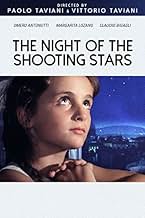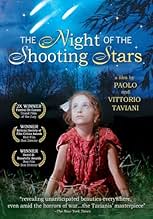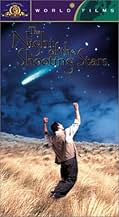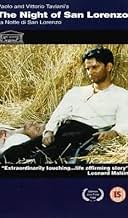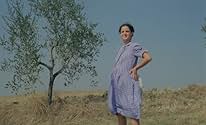AVALIAÇÃO DA IMDb
7,2/10
4,9 mil
SUA AVALIAÇÃO
Adicionar um enredo no seu idiomaIn 1944, the residents of a small Italian town under Axis control flee their homes to seek out the liberating Allied forces.In 1944, the residents of a small Italian town under Axis control flee their homes to seek out the liberating Allied forces.In 1944, the residents of a small Italian town under Axis control flee their homes to seek out the liberating Allied forces.
- Direção
- Roteiristas
- Artistas
- Prêmios
- 19 vitórias e 13 indicações no total
Sergi Dagliana
- Olinto
- (as Sergio Dagliana)
Avaliações em destaque
The Night of the Shooting Stars is the semi-autobiographical recollection by the Taviani Brothers of the night when a group of peasants in a small Tuscan village left their homes that had been mined by the Fascists to look for liberating American soldiers rumored to be on the outskirts. Set on the night of the Feast of St. Lawrence in the closing days of World War II, and enhanced by a haunting score by Nicola Piovani, the film is a tragi-comic glimpse of what the war was like to an impressionable child filtered through years of memory. It is essentially a series of vignettes combining fact, memory, and poetic imagination told in flashback by a mother recalling her days as a 6-year old girl named Cecilia caught in the middle of war.
The film focuses on the nature of a conflict in which life long friends from the same village are often engaged in the struggle on different sides. Especially vivid is a scene involving a battle in a wheat field between the villagers and home grown Fascists, and a heart wrenching confrontation between the partisans and a father with his 15-year old son. There are many other poignant moments as well: a young couple expecting a child, the village priest who is a collaborator, and an elderly couple rekindling a romance started when they were adolescents.
Night of the Shooting Stars pays homage to the tradition of neo-realism, but also includes surrealistic moments such as when the young girl sees the partisans as Greek warriors, while the Fascist who threatens her life falls dead, pierced by multiple spears. Though Night of the Shooting Stars suffers from overacting, its unique approach allows us to see war as a very personal experience with all of its sadness and cruelty. It was also gratifying to see Americans being held in high esteem, an experience we haven't enjoyed much of recently.
The film focuses on the nature of a conflict in which life long friends from the same village are often engaged in the struggle on different sides. Especially vivid is a scene involving a battle in a wheat field between the villagers and home grown Fascists, and a heart wrenching confrontation between the partisans and a father with his 15-year old son. There are many other poignant moments as well: a young couple expecting a child, the village priest who is a collaborator, and an elderly couple rekindling a romance started when they were adolescents.
Night of the Shooting Stars pays homage to the tradition of neo-realism, but also includes surrealistic moments such as when the young girl sees the partisans as Greek warriors, while the Fascist who threatens her life falls dead, pierced by multiple spears. Though Night of the Shooting Stars suffers from overacting, its unique approach allows us to see war as a very personal experience with all of its sadness and cruelty. It was also gratifying to see Americans being held in high esteem, an experience we haven't enjoyed much of recently.
The fraternal filmmaking team of Paolo and Vittorio Taviani recall the closing days of World War II with mingled affection and pain, looking back at the fate of one small northern Italian village (ostensibly their own childhood home) set in the path of opposing armies. Combining their typically lyrical approach to storytelling with a remarkable feel for setting, the two directors follow a small group of villagers as they steal through enemy lines one night in an attempt to meet the advancing Allied troops. Seen through the rose-colored lens of memory, the Taviani brothers' episodic reminiscences take the horror (but not the hurt) out of battle, reducing all the bloodshed and rage to a poignant and distinctly recalled tragedy.
If you want to know how Italians lived and felt in the Second World War, how they managed the terror, you have to watch this movie. Have you imagined your neighbors collaborating with the Nazi-Fascist army? Have you imagined can't trusting in your relatives? Have you imagined yourself being chased and having to run away on foot for kilometers? Well, most of us have never faced this situation (some of us did) and this movie is one portrait of what Nazism/Fascism was to Europe.
I recently spent two weeks near San Miniato (home town of the directors and setting for the film), so part of this film's charm for me was to revisit the beautiful Tuscan countryside. But it is also a moving portrayal of a painful moment in Italian history, as the advancing Allies, the retreating Germans, the Fascist Blackshirts, the anti-Fascist partisans, and deserters from the Italian Army all converge on a small hilltop town in Tuscany (called "San Martino" in the film). Meanwhile, ordinary civilians just try to survive and keep their dignity. Some of the townspeople accept the Germans' offer of sanctuary with the bishop in the cathedral; others strike out across the countryside to find the Americans. Each group faces the unanticipated consequences of their choices. I have the feeling that many of the actors were non-professionals - entire families appear in the cast list - and the editing & special effects are also kept very simple. (There's a great deal of violence, but almost no cinematic "blood and gore.") But perhaps that's in keeping with the somewhat "naive" perspective that the film strives for - the story is told through the eyes of an eight-year old girl. For a book that focuses on the same region and period, I'd recommend Iris Origo's "War in Val d'Orcia."
This film is an eye-opening look at Italian life during WWII. It reminds me of the stories my grandfather tells me of his life in 1930s Florence during the war, "We didn't have money for anything, not even water. The rich had it all." This movie shows us the sparseness of their lives, and the things that they still hold dear. There are scenes in which it is almost hard to watch, we are torn apart by the brutality of the war, but we are entranced by the people who are living through it. We meet ruthless fascists, and caring catholic priests and every moment describes to us the terrifying truth, and the hope that lets one continue. I could not imagine a more realistic, and emotional epic on the subject.
Você sabia?
- CuriosidadesThe church scene, where Germans bomb the church full of people, was based on real life events that took place in San Miniato (the birthplace of Paolo Taviani and Vittorio Taviani). However, more than two decades after this movie was made, the case was reopened and it was discovered, that the fatal bomb actually belonged to the American army, and hit the church accidentally.
- Erros de gravaçãoA man, likely Dilvo, raises watermelon to his mouth with both hands, but in the next shot is eating it only with the right hand.
- ConexõesFeatured in Marcello Mastroianni: Eu me Lembro Sim, Eu me Lembro (1997)
Principais escolhas
Faça login para avaliar e ver a lista de recomendações personalizadas
- How long is The Night of the Shooting Stars?Fornecido pela Alexa
Detalhes
- Data de lançamento
- País de origem
- Idiomas
- Também conhecido como
- The Night of the Shooting Stars
- Locações de filme
- Empoli, Tuscany, Itália(church bombing scene on Piazza Farinata degli Uberti)
- Empresas de produção
- Consulte mais créditos da empresa na IMDbPro
Bilheteria
- Faturamento bruto nos EUA e Canadá
- US$ 2.257.307
- Fim de semana de estreia nos EUA e Canadá
- US$ 4.414
- 16 de ago. de 2015
- Faturamento bruto mundial
- US$ 2.257.307
- Tempo de duração1 hora 47 minutos
- Mixagem de som
- Proporção
- 1.66 : 1
Contribua para esta página
Sugerir uma alteração ou adicionar conteúdo ausente

Principal brecha
By what name was A Noite de São Lourenço (1982) officially released in India in English?
Responda



